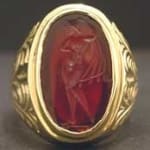Classical Revival Intaglio Depicting the God Mercury, 18th Century CE
Carnelian-Gold
FJ.6682
This Gorgeous Intaglio Has Been Set in a Modern 18 Karat Gold Rin The art of glyptics, or carving on colored precious stones, is probably one of the oldest known...
This Gorgeous Intaglio Has Been Set in a Modern 18 Karat Gold Rin
The art of glyptics, or carving on colored precious stones, is probably one of the oldest known to humanity. Intaglios, gems with an incised design, were made as early as the fourth and third millennia B.C. in Mesopotamia and the Aegean Islands. The exhibit a virtuosity of execution that suggests an old and stable tradition rooted in the earliest centuries. The tools required for carving gems were simple: a wheel with a belt-drive and a set of drills. Abrasives were necessary since the minerals used were too hard for a metal edge. A special difficulty of engraving intaglios, aside from their miniature size, was that the master had to work with a mirror-image in mind.
The Classical Revival was a phenomenon that swept through Europe in the 18th and 19th Centuries. A new appreciation for antiquity and ancient art forms was fostered by discoveries in the nascent scientific field of archaeology. Perhaps the Classical Revival also reveals a latent longing towards the Arcadian lifestyles of yesterday abandoned as Europe became rapidly industrialized and increasingly urbanized. On this stunning intaglio, the swift-footed messenger of the gods, Mercury, is depicted. He also ruled over trade and profit, thus making him quite a popular deity among merchants and traders throughout the Roman Empire. Overall, this sumptuous piece of jewelry invokes a longing for the past and a rebirth of all things beautiful.
The art of glyptics, or carving on colored precious stones, is probably one of the oldest known to humanity. Intaglios, gems with an incised design, were made as early as the fourth and third millennia B.C. in Mesopotamia and the Aegean Islands. The exhibit a virtuosity of execution that suggests an old and stable tradition rooted in the earliest centuries. The tools required for carving gems were simple: a wheel with a belt-drive and a set of drills. Abrasives were necessary since the minerals used were too hard for a metal edge. A special difficulty of engraving intaglios, aside from their miniature size, was that the master had to work with a mirror-image in mind.
The Classical Revival was a phenomenon that swept through Europe in the 18th and 19th Centuries. A new appreciation for antiquity and ancient art forms was fostered by discoveries in the nascent scientific field of archaeology. Perhaps the Classical Revival also reveals a latent longing towards the Arcadian lifestyles of yesterday abandoned as Europe became rapidly industrialized and increasingly urbanized. On this stunning intaglio, the swift-footed messenger of the gods, Mercury, is depicted. He also ruled over trade and profit, thus making him quite a popular deity among merchants and traders throughout the Roman Empire. Overall, this sumptuous piece of jewelry invokes a longing for the past and a rebirth of all things beautiful.



